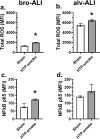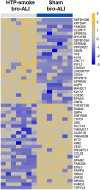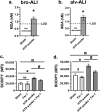Insight into the pulmonary molecular toxicity of heated tobacco products using human bronchial and alveolar mucosa models at air-liquid interface
- PMID: 36180488
- PMCID: PMC9525689
- DOI: 10.1038/s41598-022-20657-y
Insight into the pulmonary molecular toxicity of heated tobacco products using human bronchial and alveolar mucosa models at air-liquid interface
Abstract
Heated tobacco products (HTP) are novel nicotine delivery products with limited toxicological data. HTP uses heating instead of combustion to generate aerosol (HTP-smoke). Physiologically relevant human bronchial and alveolar lung mucosa models developed at air-liquid interface were exposed to HTP-smoke to assess broad toxicological response (n = 6-7; ISO puffing regimen; compared to sham; non-parametric statistical analysis; significance: p < 0.05). Elevated levels of total cellular reactive oxygen species, stress responsive nuclear factor kappa-B, and DNA damage markers [8-hydroxy-2'-deoxyguanosine, phosphorylated histone H2AX, cleaved poly-(ADP-Ribose) polymerase] were detected in HTP-smoke exposed bronchial and/or alveolar models. RNA sequencing detected differential regulation of 724 genes in the bronchial- and 121 genes in the alveolar model following HTP-smoke exposure (cut off: p ≤ 0.01; fold change: ≥ 2). Common enriched pathways included estrogen biosynthesis, ferroptosis, superoxide radical degradation, xenobiotics, and α-tocopherol degradation. Secreted levels of interleukin (IL)1ꞵ and IL8 increased in the bronchial model whereas in the alveolar model, interferon-γ and IL4 increased and IL13 decreased following HTP-smoke exposure. Increased lipid peroxidation was detected in HTP-smoke exposed bronchial and alveolar models which was inhibited by ferrostatin-1. The findings form a basis to perform independent risk assessment studies on different flavours of HTP using different puffing topography and corresponding chemical characterization.
© 2022. The Author(s).
Conflict of interest statement
The authors declare no competing interests.
Figures








Similar articles
-
Assessment of wood smoke induced pulmonary toxicity in normal- and chronic bronchitis-like bronchial and alveolar lung mucosa models at air-liquid interface.Respir Res. 2024 Jan 20;25(1):49. doi: 10.1186/s12931-024-02686-5. Respir Res. 2024. PMID: 38245732 Free PMC article.
-
New ideas, old problems? Heated tobacco products - a systematic review.Int J Occup Med Environ Health. 2019 Oct 16;32(5):595-634. doi: 10.13075/ijomeh.1896.01433. Epub 2019 Sep 26. Int J Occup Med Environ Health. 2019. PMID: 31584041
-
Cytotoxic effects of heated tobacco products (HTP) on human bronchial epithelial cells.Tob Control. 2018 Nov;27(Suppl 1):s26-s29. doi: 10.1136/tobaccocontrol-2018-054317. Epub 2018 Sep 5. Tob Control. 2018. PMID: 30185530 Free PMC article.
-
A single and short exposure to heated tobacco vapor or cigarette smoke affects macrophage activation and polarization.Toxicology. 2024 Aug;506:153859. doi: 10.1016/j.tox.2024.153859. Epub 2024 May 31. Toxicology. 2024. PMID: 38825031
-
Heated Tobacco Products: Insights into Composition and Toxicity.Toxics. 2023 Aug 2;11(8):667. doi: 10.3390/toxics11080667. Toxics. 2023. PMID: 37624172 Free PMC article. Review.
Cited by
-
Lipid from electronic cigarette-aerosol both with and without nicotine induced pro-inflammatory macrophage polarization and disrupted phagocytosis.J Inflamm (Lond). 2023 Nov 17;20(1):39. doi: 10.1186/s12950-023-00367-6. J Inflamm (Lond). 2023. PMID: 37978397 Free PMC article.
-
The Product Science of Electrically Heated Tobacco Products: An Updated Narrative Review of the Scientific Literature.Cureus. 2024 May 28;16(5):e61223. doi: 10.7759/cureus.61223. eCollection 2024 May. Cureus. 2024. PMID: 38939262 Free PMC article. Review.
-
Contrasting effects of intracellular and extracellular human PCSK9 on inflammation, lipid alteration and cell death.Commun Biol. 2024 Aug 13;7(1):985. doi: 10.1038/s42003-024-06674-9. Commun Biol. 2024. PMID: 39138259 Free PMC article.
-
The Health Effects of Heated Tobacco Product Use-A Narrative Review.Healthcare (Basel). 2025 Aug 18;13(16):2042. doi: 10.3390/healthcare13162042. Healthcare (Basel). 2025. PMID: 40868658 Free PMC article. Review.
-
Effects of unburned tobacco smoke on inflammatory and oxidative mediators in the rat prefrontal cortex.Front Pharmacol. 2024 Jan 25;15:1328917. doi: 10.3389/fphar.2024.1328917. eCollection 2024. Front Pharmacol. 2024. PMID: 38333013 Free PMC article.
References
-
- https://www.euro.who.int/__data/assets/pdf_file/0008/443663/Heated-tobac.... (2020). [Accessed 14.02.2022].
-
- Heated tobacco products: Information sheet, 2nd Edn. https://www.who.int/publications/i/item/WHO-HEP-HPR-2020.2 (2020). [Accessed 14.02.2022].
-
- Heated tobacco products. https://www.cdc.gov/tobacco/basic_information/heated-tobacco-products/ (2020). [Accessed 14.02.2022].
Publication types
MeSH terms
Substances
LinkOut - more resources
Full Text Sources
Molecular Biology Databases

